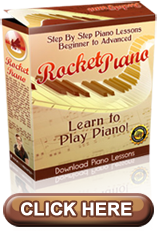
There are lots of fun piano game for the whole family that you can play using piano by number books. Here are just a few:
Name That Tune: One person plays the songs on the piano while everyone tries to guess the title of the song. Kids love playing the songs, so kids can take turns. You can also use the Play Along Audio CD, but kids also love being the center of attention and playing the songs on the piano.
Musical Chairs: Put chairs in center of room and when the music stops everyone has to find a chair, except there's always one chair too few. Use the CDs or have the kids (any age) play the piano.
Christmas Pageant: There's more than enough material on the Play Along Audio CD to present your own show. Kids (any age) will love putting it together, and can take turns playing along with the music or acting in the show.
Make Up Your Own Show: The Family Favorites section has 28 familiar melodies that creative kids can turn into a show about anything.
Have Everyone Try It! You'd be surprised what fun a family gathering can become when everyone is asked to play a song from the book. You'll discover that your family and friends have hidden musical talents! Most people really do want to try playing the piano, so make a game of it!
TEACHING GAMES
FOURS "Fours" is the most basic rhythm game that I play with kids. I always use it on the first lesson, and on all subsequent lessons until the child seems too old for it. It's a fun but very childish game that teaches rhythm and piano geography without using printed notes or numbers of any kind.It's important for kids to actually play the piano without the encumbrance of graphic notation (notes or numbers) of any kind. For example, you'll notice that kids in general can go to the piano and play three songs: Chopsticks, Heart and Soul, Knuckles (that funny piece played on the black keys with the knuckles of the right hand!)
"Fours" is a piano game constructed in exactly the same mold. The child plays numbers and I play the chords. If the symbols below don't line up in your browser, remember that there are always four notes (numbers) for every chord (letter.) The child begins on "Middle C," also known as the number one: "1" The teacher plays the letters, or chords.
1111 2222 3333 4444 5555 6666 7777 8888
C G C F C F G C
I play a kind of funny Chico Marx oom-pah accompaniment using the chord pattern (C G C F C F G C, etc.) Kids find this very easy and refreshing. We play up the piano keys, moving to the right, with the natural goal being for the child to reach the highest key on the piano. I'm pretty "strict," that is, if the child breaks the rhythm or misses a key, we start over. Strangely enough, kids love to go back to the beginning and start over as much as they love going all the way to highest key.
Fun variant: Ask them to count up the white keys until they reach the highest white key (starting from Middle C, which to them is #1) and tell you what the "number" of that white key is (it's 29.) This has no musical value except that it makes the child an explorer of the instrument.The object of these games is to make the child a keen and enthusiastic observer of their instrument, something impossible to do when the child is locked into reading only sheet music from a book. Kids need to improvise, however humbly, and essentially all of my games are designed to make fun music outside of sheet music, numbers or conventional.
"Fours" teaches a child that
Sheet music is not always necessary to have fun with music
They have to count while they play
Music is divided into numbered units
Piano is a fun thing they can do right away.



0 comments:
Post a Comment